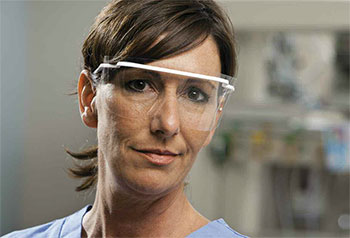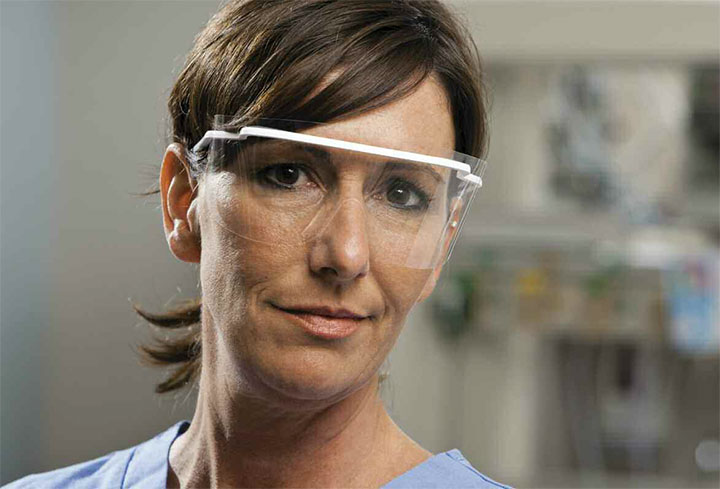Authors: Amber Hogan Mitchell, DrPH, MPH, CPH and Linda Powell, MSN, RN, FNP
Learn how to reduce the risk and what to do if an injury occurs.
Takeaways:
- Preventing blood and body fluid exposures depends on surveillance, ongoing education, and adherence to a hierarchy of controls, such as personal protective equipment.
- The estimated cost of each eye exposure incident is more than $1,000.
- To build the best interventional programs, detailed information is needed so that targeted approaches can be used to avoid recurrence.
By Amber Hogan Mitchell, DrPH, MPH, CPH and Linda Powell, MSN, RN, FNP
Editor’s note:In this second of a two-part series on protecting your eyes from splashed body fluids that may contain pathogens, we share insights from two experts: Amber Hogan Mitchell, DrPH, MPH, CPH, president and executive director of the International Safety Center; and Linda Powell, MSN, RN, FNP, workers’ compensation case manager for Scripps Green/Scripps Encinitas in California. Access the first article of this series at myamericannurse.com/?p=41195.
Why do organizations need to track incidents of splashes?
Mitchell: Preventing blood and body fluid exposures (BBFEs) depends on three key elements: surveillance, ongoing education, and adherence to a hierarchy of controls, such as personal protective equipment (PPE). The hierarchy of controls is implemented to provide inherently safer systems in healthcare. The controls at the top of the hierarchy are more effectively implemented at an institutional/organizational level. Although PPE sits at the bottom of the hierarchy, for BBFEs it’s frequently the most effective form of control because exposures have an immediate impact to nurses while providing direct care.
Without surveillance, which includes robust exposure incident reporting and recording systems, an organization can’t identify where the risks are, what’s causing them, and what can be done to prevent them from recurring. All of this information is necessary to tailor education and adjust work practices.
Starting in July 2018, the Occupational Safety and Health Administration (OSHA) will require employers to submit their injury and illness records (OSHA 300, 300A) to the agency electronically, reflecting the government’s focus on the importance of surveillance and exposure tracking as a way to identify risks that can be measured and controlled. Keeping thorough incident reports about splashes as they occur can help an organization improve its recordkeeping for other exposure types, such as needlestick injuries.
Powell: In addition to protecting employees, organizations need to know the financial implications of these incidents. We estimate that the cost of each incident is more than $1,000, which includes the cost of laboratory testing for patients and the employees, the patient’s visit to the health clinic, and claim processing. Should the employee test positive for a bloodborne pathogen, costs escalate dramatically.
Mitchell: According to Exposure Prevention Information Network (EPINet®) data, the majority of expenses come from testing the patient and employee so that appropriate postexposure follow-up can be conducted. If there is a seropositive source, costs can skyrocket from the need for prolonged postexposure prophylaxis for conditions such as HIV.
How should organizations track BBFEs?
Mitchell: Just recording an exposure by collecting information on the date and location of the incident isn’t enough. To build the best interventional programs, detailed information is needed so that targeted approaches can be developed to avoid recurrence. (See Collecting the data.)
Collecting the data
[su_note note_color=”#c1e8dd” text_color=”#2f2f2f”]
The Exposure Prevention Information Network (EPINet®) is a freeware surveillance system developed in 1992 to help facilities collect the following information about blood and body fluid exposures (mucocutaneous):
With this kind of detail, the facility’s leaders can adjust programs based on exposures experienced in their practice setting. For example, if an eye splash occurred in a patient or exam room and the nurse indicated not wearing eye protection, this information can be used to assess whether eye protection was readily accessible in the area where it was needed or if accommodations should be made to improve placement (for example, installing or adding eye shields to a wall or door caddy). Other items can be added to make overall employee health surveillance and recording systems function in parallel; for instance, if the incident was Occupational Safety and Health Administration (OSHA) recordable (more than first aid was administered), if postexposure prophylaxis was given or prescribed, and if the incident was a result of a medical device failure. These elements can feed into OSHA recordkeeping, occupational safety and health, occupational medicine, and adverse event reporting to the Food and Drug Administration. The 2018 EPINet Blood and Body Fluid Exposure Report form is available online. Contact the International Safety Center if you’re interested in becoming an EPINet user and receiving the surveillance database or becoming a part of their reporting network. |
[/su_note]
For example, if an eye splash occurred in a patient room and the nurse wasn’t wearing eye protection, this information could be used to assess whether eye protection was readily accessible in the area where it was needed or if it should be placed in a caddy on the door or wall of patients’ rooms.
What techniques did you find to be effective in implementing eye protection?
Powell: We realized that although hanging the eye shields on the wall would encourage their use, we needed to take other actions to change staff habits. Much like the introduction of other PPE, the effort had to be ongoing and persistent. We also knew that we needed manager buy-in and staff involvement, and that any change had to be time- and cost-effective.
Helpful strategies included the following:
- We put eye shield containers on the wall next to the glove containers and encouraged staff to pull gloves and eye shields at the same time.
- We worked with managers to create a list of situations when staff were expected to use eye protection. We turned the list into a colorful flyer and posted it in each unit’s dirty utility room.
- We coordinated between unit managers and supply chain staff to set a go-live date and to establish resupply levels for each unit.
- Before going live, we sent an email to all clinical staff describing the shields, where they would be placed, when to use them, and how the containers would be refilled.
- Managers discussed eye shields at shift huddles, reviewing when and how to use them and how to refill containers. Performance expectations were relayed to all staff.
- Initial education included 3- to 4-minute roving staff development sessions, literally catching staff members as they entered and left patients’ rooms. These sessions were scheduled for different days and shifts to reach as many clinical staff as possible.
What kind of ongoing follow-up do you continue to do to ensure compliance with eye protection?
Powell: During ongoing, quick (about 5 minutes) biweekly safety rounds, the director of wellness and the facility safety champion check if eye shield containers are properly filled and note units where multiple containers are found empty. The good news about empty containers is that the shields are being used; the bad news is that they aren’t available for the next staff member. The facility champion discusses challenges with managers and assists in overcoming them. Emphasis is placed on changing staff habits, rather than punitive criticism.
What should be done when an eye splash occurs?
 Powell: When an exposure occurs, employees should irrigate the eye with clean water, saline, or sterile irrigant, report the incident to their supervisor, and seek medical evaluation. At our organization, the affected employee also notifies our workers’ compensation carrier. An injury report is generated, and the workers’ compensation case manager contacts the employee immediately. The case manager asks the employee why and how the exposure occurred and encourages him or her to troubleshoot the incident by asking how it could have been prevented, including how wearing eye protection could have avoided the exposure. This discussion helps identity any larger issues; for example, in one case, we learned that defective equipment contributed to the splash exposure. We also recruit the staff member as a champion in the prevention of future incidents.
Powell: When an exposure occurs, employees should irrigate the eye with clean water, saline, or sterile irrigant, report the incident to their supervisor, and seek medical evaluation. At our organization, the affected employee also notifies our workers’ compensation carrier. An injury report is generated, and the workers’ compensation case manager contacts the employee immediately. The case manager asks the employee why and how the exposure occurred and encourages him or her to troubleshoot the incident by asking how it could have been prevented, including how wearing eye protection could have avoided the exposure. This discussion helps identity any larger issues; for example, in one case, we learned that defective equipment contributed to the splash exposure. We also recruit the staff member as a champion in the prevention of future incidents.
Care is arranged at our employee health clinic. To close the circle, the manager discusses the incident with the employee, completes an injury review form that details how the incident could have been prevented, and develops an action plan for preventing future incidents. The action plan may include individual education and increased discussion about prevention during staff huddles.
How else should the organization follow up?
Powell: We discuss all exposure incidents during a monthly multidisciplinary injury review meeting. Monthly reports provide the number of exposures and where they occurred. The goal is reduction of injuries, not assignment of blame. For example, managers from units that have more exposures can troubleshoot with managers who have fewer. We have found the review to be very effective.
The workers’ compensation case manager monitors staff members who have more than one exposure and staff members who are not wearing eye protection. Managers are notified if additional follow-up is needed.
Mitchell: The only way to know if occupational health and safety and risk-mitigation efforts are successful is to measure how they impact employees over time. Capturing as much important information about an exposure incident as possible (and appropriate) serves to reassure employees that the organization is doing as much as it can to put controls, education, and training in place to protect them today, tomorrow, and well into the future.
Have you seen a reduction in exposures as a result of your efforts?
Powell: Changing habits takes time, so we measure the number of preventable incidents on a quarterly basis. We immediately saw a decrease in exposures, and our goal is to have a greater reduction within two calendar years.
This series is supported by an unrestricted educational grant from Tidi Products (tidiproducts.com).
[pdf-embedder url=”https://www.myamericannurse.com/wp-content/uploads/2018/04/ant4-Splash-Safety-327.pdf” title=”ant4-Splash Safety-327″]
